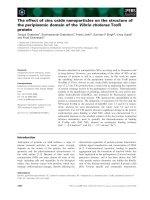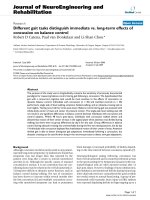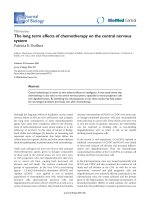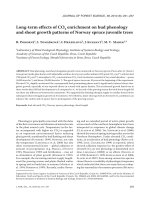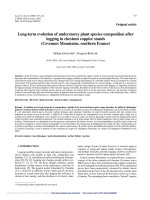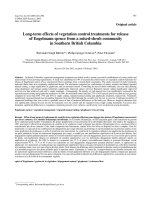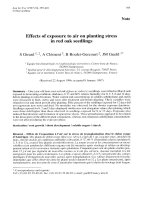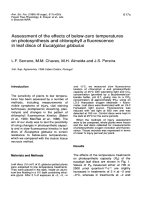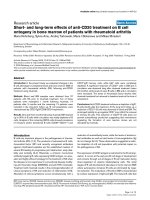Long term effects of zinc oxide nanoparticles on wastewater treatment in a membrane bioreactor (MBR) process
Bạn đang xem bản rút gọn của tài liệu. Xem và tải ngay bản đầy đủ của tài liệu tại đây (2.87 MB, 144 trang )
LONG-TERM EFFECTS OF ZINC OXIDE
NANOPARTICLES ON WASTEWATER
TREATMENT IN A MEMBRANE BIOREACTOR
(MBR) PROCESS
TAN SIEW YEN, MAGDALENE
(B.Eng.(Hons.), NUS
A THESIS SUBMITTED
FOR THE DEGREE OF MASTER OF
ENGINEERING
DEPARTMENT OF CHEMICAL AND
BIOMOLECULAR ENGINEERING
NATIONAL UNIVERSITY OF SINGAPORE
2015
i
i
ACKNOWLEDGEMENTS
I would hereby like to express my deepest gratitude to my Project Supervisor,
Associate Professor Ting Yen Peng for his invaluable advice and guidance
throughout the course of this project.
Special thanks are also extended to Dr. Qiu Guang Lei who did his utmost in
supervising and guiding me throughout the project. I am truly grateful by his
support and assistance offered in the course of this project.
I would also like to express appreciate to all my laboratory mates, namely
Divya Shankari Srinivasa Ragha, Shruti Vyas, Subhabrata Das, Thulasya
Ramanathan and Gayathri Natarajan, and laboratory officer, Sylvia Wan, for
their constant help and support while conducting the study in the laboratory.
Lastly, I would like to express my sincere gratitude to my family and friends
for their constant support and encouragement.
ii
This page is intentionally left blank.
iii
TABLE OF CONTENTS
DECLARATION
i
ACKNOWLEDGEMENTS
ii
TABLE OF CONTENTS
iv
SUMMARY
vii
LIST OF TABLES
ix
LIST OF FIGURES
x
NOMENCLATURE
xii
1. INTRODUCTION
1
1.1 Nanoparticles
1
1.2 Zinc oxide nanoparticles
3
1.3 Membrane bioreactors
6
1.4 Objectives of research
8
1.5 Scope of research
8
1.6 Schedule of various experimental phases
2. LITERATURE REVIEW
2.1 Zinc oxide nanoparticles
10
11
11
2.1.1 Environment relevant concentrations
12
2.1.2 Stability of zinc oxide nanoparticles in aqueous
environment
17
2.2 Ecotoxicity effects of zinc oxide nanoparticles
19
2.2.1 Mechanisms of zinc oxide nanoparticles
21
2.2.2 Effects of zinc oxide nanoparticles on bacteria
23
2.2.3 Effects of zinc oxide nanoparticles on wastewater
treatment
25
2.3 Membrane bioreactors
29
iv
2.3.1 Introduction
29
2.3.2 ZnO nanoparticles in MBRs
34
2.3.3 Membrane fouling
39
2.3.4 Membrane fouling control
44
3. MATERIALS AND METHODS
47
3.1 Experimental setup
47
3.2 Operating conditions in the MBR system
49
3.3 Synthetic municipal wastewater feed
50
3.4 Analytical methods
51
3.4.1 Wastewater characteristics
52
3.4.2 Sludge characteristics
54
3.4.3 Membrane fouling rate
55
3.4.4 Zinc phosphate precipitate in mixed liquor
55
3.4.5 Soluble Microbial Products (SMP) and Extracellular
Polymeric Substances (EPS)
56
3.4.6 Bacterial community dynamics
57
3.4.7 Zn content in wastewater and activated sludge
59
4. RESULTS AND DISCUSSION
60
4.1 Standard curves
60
4.2 Effect of ZnO nanoparticles on wastewater treatment
60
4.2.1 Wastewater characteristics
61
4.2.2 Sludge characteristics
71
4.2.2.1 MLSS, MLVSS, SVI and Sludge morphology
71
4.2.2.2 Soluble microbial substances (SMP) and
Extracellular polymeric substances (EPS)
78
4.3 Fate of ZnO nanoparticles
4.3.1 Solubility of ZnO NPs
88
88
v
4.3.2 Removal behaviour of ZnO NPs
89
4.3.3 Mass balance of Zn
92
4.4 ZnO nanoparticles effect on bacterial community
96
5. CONCLUSIONS
100
5.1 Effects of ZnO NPs on removal efficiencies
100
5.2 Effects of ZnO NPs on sludge characteristics
101
5.3 Effects of ZnO NPs on bacteria community in MBR
101
5.4 Fate of ZnO NPs in MBR
102
6. FURTHER STUDIES
103
6.1 Effect of ZnO NPs in MBR using municipal wastewater
103
6.2 Transformation of ZnO NPs in MBR system
104
6.3 Impact of ZnO NPs on MBR bacterial community
105
6.4 Effect of ZnO NPs on physiochemical stability of MBR
activated sludge flocs
105
6.5 Impact of ZnO NPs on membrane fouling
106
7. REFERENCES
107
APPENDIX
123
Appendix A1: Standard Curves
123
Appendix A2: EDX Analysis
127
vi
SUMMARY
In recent years, the growing release of zinc oxide nanoparticles (ZnO NPs)
from consumer-products in various sectors into sewage systems has raised
concerns on the potential adverse impact on wastewater treatment plants.
MBR systems, which have been widely used since 1990s for municipal
wastewater treatment, are traditionally not designed to cope with the removal
of nanoparticles. At present, the effect of this new emerging pollutant, ZnONPs, on the performance of MBR system is still largely unknown.
In this study, the effect of zinc oxide nanoparticles (ZnO-NPs) on the system
performance and its removal behaviour in an MBR system were investigated.
A lab-scale submerged MBR system was operated continuously for 242 days.
Three experimental phases were conducted, with 0, 1 mg/L and 10 mg/L of
ZnO NPs added into the system over the whole duration. Significant changes
in COD, TN and phosphorous removal efficiency of the system were observed
with the addition of 1 mg/L and 10 mg/L ZnO NPs. Concentrations of proteins
and polysaccharides in SMPs showed significant changes while that of EPSs
were affected to a smaller extent.
The MBR system was efficient in removing ZnO-NPs from the wastewater,
achieving higher than 95% removal efficiency on almost all days. Sorption
onto biomass works well as the main removal mechanism at low ZnO-NPs
vii
concentration while membrane rejection also plays a part in the removal of Zn
when concentration was increased to 10 mg/L.
ZnO-NPs caused a major shift in the bacterial community structure but no
significant change in community diversity as revealed from 16S rRNA genebased PCR-DGGE analysis. In addition, the type of EPS also changed from
those enveloping the sludge to those forming a dense matrix around the
bacteria cells.
KEYWORDS
Membrane
bioreactor;
municipal
wastewater
treatment;
zinc
oxide
nanoparticles; membrane fouling; extracellular polymeric substances (EPS),
bacterial community dynamics
viii
LIST OF TABLES
Table 2.1
Potential fate of nanoparticles in aquatic systems
13
Table 2.2
Concentration of nanomaterials in consumer products
(in g/kg or mg/kg product) and the consequent added
concentration and releases in the Dutch reaches of the
Rhine and Meuse
14
Table 2.3
Modeled concentrations of ZnO nanoparticles released
into environmental compartments in different
countries, shown as mode (most frequent value) and as
range of the lower and upper quantiles (Q0.15 and
0.85)
15
Table 2.4
Some common nanoparticles, their respective
applications, and some estimates of their potential
environmental size concentrations
16
Table 2.5
Typical MBR effluent quality
31
Table 3.1
Composition of synthetic wastewater
50
Table 4.1
Summary of effects of ZnO NPs on nutrient removal in
70
wastewater
Table 4.2
Shannon-Wiener diversity index of the bacterial
community in MBR
98
ix
LIST OF FIGURES
Figure 2.1
Wastewater treatment using a) CAS process and b) MBR
31
Figure 2.2
Simplified diagrams of a) Submerged MBR and b)
External MBR
33
Figure 3.1
Schematic set-up of lab-scale MBR system
47
Figure 3.2
Photograph of lab-scale MBR setup
49
Figure 4.1
COD removal in MBR before and after ZnO-NPs dosage
61
Figure 4.2
NH4+-N removal in MBR before and after ZnO-NPs
dosage
62
Figure 4.3
NO2--N removal in MBR before and after ZnO-NPs
dosage
63
Figure 4.4
NO3--N removal in MBR before and after ZnO-NPs
dosage
63
Figure 4.5
TN removal in MBR before and after ZnO-NPs dosage
64
Figure 4.6
PO43--P removal in MBR before and after ZnO NPs
dosage
68
Figure 4.7
Phosphate precipitates in the reactor
68
Figure 4.8
Changes in physical appearance of MBR reactor sludge
(a. sludge inoculum, b. Day 89, c. Day 162, d. Day 242)
71
Figure 4.9
SEM observation of the activated sludge during the
operation of the MBR (a. sludge inoculum, b. Day 69, c.
Day 161, d. Day 240)
74
Figure 4.10
Changes in MLSS, MLVSS and SVI during the operation
of MBR
76
Figure 4.11
Changes in physical appearance of MBR reactor sludge
(a. sludge inoculum, b. Day 89, c. Day 162, d. Day 242)
79
Figure 4.12a
Changes in SMP during the operation of MBR
81
Figure 4.12b Changes in EPS during operation of MBR
Figure 4.13
Soluble Zn2+ and total Zn concentrations in influent
81
88
x
Figure 4.14
ZnO NPs removal and the changes in Zn content in
activated sludge in the MBR
89
Figure 4.15
Changes in Zn content in influent, effluent and
supernatant
91
Figure 4.16
Mass balance of total Zn in the MBR
93
Figure 4.17
DGGE fingerprint patterns of MBR bacterial community
96
Figure 4.18
Cluster analysis of bacterial community dynamics in
MBR
98
Figure A1.1
Standard curve for COD (High concentration)
123
Figure A1.2
Standard curve for COD (Low concentration)
123
Figure A1.3
Standard curve for NH4+-N
124
Figure A1.4
Standard curve for NO2--N
124
Figure A1.5
Standard curve for NO3--N
125
Figure A1.6
Standard curve for PO43--P
125
Figure A1.7
Standard curve for Polysaccharides
126
Figure A1.8
Standard curve for Proteins
126
Figure A2.1
Elemental content of sludge on Day 69
127
Figure A2.2
Elemental content of sludge on Day 140
128
Figure A2.3
Elemental content of sludge on Day 214
129
Figure A2.4
Elemental content of sludge on Day 240
130
xi
NOMENCLATURE
ANOVA
Analysis of Variance
BSA
Bovine Serum Albumin
CAS
Conventional Activated Sludge
COD
Chemical Oxygen Demand
DGGE
Denaturing Gradient Gel Electrophoresis
EC50
Half Maximum Effective Concentration
EDX
Energy-Dispersive X-ray Spectroscopy
ENM
Engineered Nanomaterials
ENP
Engineered Nanoparticles
EPS
Extracellular Polymeric Substances
F/M
Food to Microorganisms Ratio
HDD
Hydrodynamic Diameter
HRT
Hydraulic Retention Time
IC50
Half Maximum Inhibitory Concentration
ICP-MS
Inductively Coupled Plasma - Mass Spectrometer
LC50
Lethal Concentration 50
MBR
Membrane Bioreactor
MF
Microfiltration
MLSS
Mixed Liquor Suspended Solids
MLVSS
Mixed Liquor Volatile Suspended Solids
NOM
Natural organic matter
PCR
Polymerase Chain Reaction
PVDF
Polyvinylidene Fluoride
RH
Relative Hydrophobicity
ROS
Reactive Oxygen Species
RT-PCR
Real-time Reverse Transcription-PCR
xii
SBR
Sequencing Batch Reactor
SEM
Scanning Electron Microscopy
SMP
Soluble Microbial Products
SRT
Solid Retention Time
SVI
Sludge Volume Index
T-RFLP
Terminal Restricted Fragment Length Polymorphism
TMP
Transmembrane Pressure
TN
Total Nitrogen
UASB
Upflow Anaerobic Sludge Blanket
UF
Ultrafiltration
UPGMA
Unweighted Pair Group Method with Arithmatic Mean
UV-Vis
Ultraviolet-Visible Light
ZnO NPs
Zinc Oxide Nanoparticles
xiii
INTRODUCTION
1. 1 Nanoparticles
Nanotechnologies development started in the 1980s with the making of a new
type of microscope (atomic force microscope) which allows not only
observation, but physical manipulation of objects at molecular and atomic
levels. Nanoparticles are defined as having two or three dimensions between 1
and 100 nm (ASTM International, 2006) and can feature different physical and
chemical properties compared to their bulk materials. This extremely small
feature size at the nanoscale means that the nanoparticles are of the same scale
as the critical size for physical phenomena. Fundamental electronic, magnetic,
optical, chemical and biological processes are different at nano-levels. In
nanomaterials, the small size also ensures that many atoms will be near
interfaces. As a result, surface properties such as energy levels, electronic
structure and reactivity are quite different from those in bulk materials, giving
rise to different and new material properties. These novel properties make
nanoparticles attractive choices for product development in a wide spectrum of
sectors, including biomedical applications, food, agriculture, information
technology, energy production and more.
However, such exceptional properties of nanoparticles might not only favour
their applications, but at the same time cause their novel toxicity.
Nanoparticles may be more toxic than larger particles of the same substance
(Lam et al., 2004) because of their larger surface area, high ratio of particle
number to mass, enhanced chemical reactivity, and potential for easier
1
penetration of cells (Gurr et al., 2005). To give some perspective to the role of
size, consider that 2 g of 100 nm-diameter nanoparticles apportioned equally
to a potential exposure of some 300 000 particles per individual (Hardman,
2006). It had been found that the reactive surface of nanoparticles can result
in the direct generation of harmful oxyradicals termed reactive oxygen species
(ROS) which can cause cell injury by attacking DNA, proteins and membranes
(Moore, 2006). Furthermore, the ability of these particles to penetrate the body
and cells provides potential routes for the delivery of nanoparticle-associated
toxic pollutants to sites where they would not normally go. Nanoparticles can
then behave like a vector on which hazardous compounds are concentrated.
While medicinal applications of nanoparticles benefit from the same property
to deliver drugs to diseased cells in order to improve the bioavailability of a
drug, biodistribution of some nanoparticles may not be known exactly, so they
may accumulate in the body over time, leading to potential dangers.
Particles in the nano-size range, for example soot and organic colloids, have
been present on earth for millions of years. However, in recent years,
nanoparticles have attracted a lot of attention because of our increasing ability
to synthesize and manipulate such materials. The Woodrow Wilson Database
listed an inventory of 1317 consumer products containing engineered
nanoparticles on the market in March 2011 which has grown by nearly 521%
since March 2006. Commercially important nanoparticles include metal oxide
nanopowders, such as silica (SiO2), titania (TiO2), alumina (Al2O3) or iron
oxides (Fe3O4, Fe2O3), and other nanoparticle materials like semiconductors
metals or alloys. Besides these, molecules of special interest that fall within
2
the range of nanotechnology are fullerenes and dendrimers (tree-like
molecules with defined cavities), which may find application for example as
drug carriers in medicine.
With estimates for the production of engineered nanomaterials expected to
increase to 58000 tons per year between 2011 and 2020 (UNEP, 2007), it is
inevitable that engineered NPs from nanoscale products and by-products will
be released into soils, sediments and aquatic ecosystems, since industrial
products and wastes inevitably end up in waterways (e.g., drainage ditches,
rivers, lakes, estuaries and coastal waters) despite safeguards. Meanwhile
concerns on their potential adverse effects on microorganisms and the
environment are gradually emerging and are not yet well understood (Pan et
al.,2010, Woodrow Wilson Database, 2011). Occasionally, accidental spillages
or permitted release of industrial effluents in aquatic systems could also lead
to direct exposure to nanoparticles for humans via inhalation of water aerosols,
skin contact and direct ingestion of contaminated drinking water or particles
adsorbed on vegetables or other foodstuffs (Moore, 2006). More indirect
exposure could arise from ingestion of organisms such as fish and shellfish
(i.e. mollusks and crustaceans) as a part of the human diet.
1. 2 Zinc oxide nanoparticles
Due to its excellent UV absorption and reflective properties, ZnO-NPs are
common constituents in many consumer products such as sunscreen,
cosmetics, paints and coatings etc. In the period 2003 to 2004, global
3
production of NPs, consisting of titanium dioxide and zinc oxide, in sunscreen
products was estimated to be approximately 1000 tonnes (Borm et al., 2006a).
In a most recent study, the annual production of ZnO-NPs was predicted to be
1600 tonnes in European Union countries alone in 2012 (Sun et al., 2014).
The discovery of new application areas may further increase the production
volumes, and lead to a proliferation of ZnO-NPs in the environment in the
near future.
Currently, there is no evidence to suggest that humans are adversely affected
by ZnO-NPs through their use in consumer products. However, ZnO NPs are
known to partially dissolve in water, hence ZnO-NP-containing products are
likely to release both dissolved zinc and ZnO-NP into the environment which
are likely to persist and bioaccumulate. Ecotoxicological literature has
reported the adverse effect of ZnO-NPs on bacteria and other microbes, algae
and plants, invertebrates, and vertebrates (Ma et al., 2013). Other studies have
shown that concentrations of 10 ng/L to 500 ng/L of ZnO-NPs in surface
waters and sewage sludge respectively are potentially problematic (Mueller
and Nowack, 2008; Gottschalk et al., 2009; Nowack 2009).
In view of the emerging concern of ZnO-NPs, risk assessment studies of
engineered nanoparticles (ENP)-containing zinc oxide have identified
wastewater treatment plants as important intermediate barriers in controlling
the release of ENPs from consumer products into the aquatic environment.
Indeed, the presence of ZnO NPs in WWTPs has been frequently reported in
recent years (Gottschalk et al., 2009; Ma et al., 2013). This brings about a
4
new interest in the effect of ZnO-NPs on wastewater microorganisms. Since
ZnO-NPs are known to have anti-microbial properties, it will be fair to
postulate that their release into wastewater systems may adversely affect the
microbial communities found in biological treatment processes. In this case,
released ZnO-NPs could potentially decrease the effectiveness of contaminant
removal in biological treatment processes and cause non-compliance with
effluent discharge limits.
Hence, there is a critical need to evaluate whether or not ZnO-NPs exhibit
toxicity to wastewater sludge to the extent that it affects the wastewater
treatment efficiency significantly. It remains to be seen whether bacteria in the
activated sludge is protected significantly enough by the extracellular
polymeric substances (EPS) and whether there is toxicity in the form of
respiration inhibition when exposed to ZnO-NPs. It had been suggested in
several studies that bioaccumulation is a major pathway for nanoparticles
removal from wastewater, and it would be necessary to investigate the case for
ZnO-NPs which will have impact on further downstream processes such as
sludge treatment and disposal. At present, it is also unknown whether changes
in speciation of ZnO-NPs (i.e. dissolution to free Zn ions or precipitation as
ZnS) will occur in wastewater and the potential toxicity, if any. In view of
these issues, it is important that the fate and transformation of ZnO-NPs during
the wastewater treatment process be examined in detail. Lastly, it is also
important to study the changes in bacteria community structure due to longterm exposure of ZnO-NPs in order to gain more insight into the microbialNPs interaction in wastewater treatment process.
5
1.3 Membrane Bioreactors
Over the past decade, membrane bioreactor (MBR) systems have emerged as
an effective solution to transforming various wastewaters into high quality
effluent for meeting stricter discharge regulations. Membrane bioreactors
(MBR) combine the use of biological processes and membrane technology to
treat wastewater. After removal of soluble biodegradable matter in the
biological process, any biomass formed needs to be separated from the liquid
stream to produce the required effluent quality. In the conventional process, a
secondary settling tank is used for such solid/liquid separation and this
clarification is often the limiting factor in effluent quality. Membrane
filtration, on the other hand, makes use of a membrane as a barrier between
two phases to achieve separation. The main advantages of choosing MBR over
the conventional activated sludge system (CAS) in wastewater treatment are
lower sludge production and smaller carbon footprint. Conversely, the main
challenges are in higher energy and equipment costs and membrane fouling.
In wastewater treatment using MBR, ultrafiltration (UF) membranes of pore
size 0.1-0.4 µm are typically used, and thus able to remove bacteria and other
micron-sized pollutants from wastewater. The question of how effective MBR
is in removing nanoparticles, specifically ZnO-NP, now arises. Typical
wastewater treatment systems, MBRs included, are not designed to treat
wastewater containing significant amounts of nanoparticles. The mechanisms
of particle transport and the impact of particle size during wastewater
treatment have traditionally been studied for micron sized pollutants, but very
6
little information is currently available on the fate of nanoscale materials in
treatment processes.
Several studies had confirmed that a considerable amount of the NPs,
including zinc oxide, released into the activated sludge process can be
absorbed by the activated sludge, resulting in a reduction of NPs in the
effluent and an accumulation in the biomass (Kaegi et al., 2011). Once
attached to biomass, the removal of nanoparticles is associated with the
settling and removal of the biomass. Hence any impact on the sludge
properties due to the long-term presence of ZnO-NPs may affect sludge
settling and eventually result in poorer Zn removal efficiency. Since MBR
systems work by principle of filtration instead of settling, it is predicted that
there will be higher ZnO-NPs removal efficiency from wastewater. However,
bearing in mind that microbial community in MBR differs significantly from
that in CAS, and hence very likely to have different microbial-ZnO NPs
interactions, more work needs to be done to evaluate the removal efficiency of
ZnO-NPs by MBR.
There is a glaring gap in knowledge in the fate and effect of nanoparticles in
MBR systems for wastewater treatment. Most studies were done on simulated
CAS processes with conditions very different from those in MBR systems. For
example, microbial community analyses had revealed significant differences
between the two systems, and floc size in MBR mixed liquor was also
reported to be smaller than that in CAS system. Currently, the effect of the
presence of ZnO-NPs on the MBR bacteria community is largely unknown. It
7
will also be important to investigate the influence of ZnO-NPs in wastewater
on membrane fouling, which remains a key challenge in MBR operation. As
both membrane fouling and microbial-ZnO NPs interactions had been found to
have links with extracellular polymerous substances (EPS) production, this is
an area that requires further study. The roles of all these factors on the
performance of the MBR system and in ZnO-NPs removal were investigated
in this study.
1.4 Objectives of research
In this research, the primary interest was to investigate the effect of ZnO-NPs
on an MBR system, with the following main objectives:
To examine the effect of ZnO-NPs on the treatment efficiencies of MBR
system in wastewater treatment
To examine the removal of ZnO-NPs by MBR
To examine the microbial community in MBR in the presence of ZnO-NPs.
1.5 Scope of research
To achieve these objectives, the scope of this research included investigating:
The total carbon, total nitrogen and total phosphate removal in the
MBR by monitoring various water qualities (i.e. TOC, NH4+-N, NO3- N, NO2- -N, PO43- -P) in the influent, mixed liquor and effluent of the
MBR system.
8
The sludge characteristics in the MBR system by monitoring Mixed
Liquor Suspended Solid (MLSS), Mixed Liquor Volatile Suspended
Solid (MLVSS) and Sludge Volume Index (SVI).
The Trans-Membrane Pressure (TMP) of the MBR system to monitor
membrane fouling rate.
The Soluble Microbial Products (SMP) and Extracellular Polymeric
Substances (EPS) contents in the activated sludge, which were
monitored and quantified in terms of polysaccharide and protein
content.
The effect of ZnO-NPs on activated sludge by monitoring any changes
in morphology of activated sludge before and after addition of ZnONPs into the MBR system using Scanning Electron Microscopy (SEM).
The effect of ZnO-NPs on the bacteria community dynamics in the
activated sludge using Denaturing Gradient Gel Electrophoresis
(DGGE).
The amount of ZnO-NPs in the influent, mixed liquor and effluent of
the MBR system to monitor the removal efficiency of ZnO-NPs in the
MBR system, and
The ZnO-NPs particle size distribution and zeta potential of activated
sludge.
9
1.6 Schedule of Various Experimental Phases
This study consisted of Phase 1, 2 and 3. Phase 1 consisted of running and
observation of the MBR system prior to ZnO-NPs loading. The performance
of MBR in terms of organic matter, total nitrogen and total phosphorus
removal, bacterial community dynamics in the activated sludge and membrane
fouling rate were monitored throughout Phase 1 for a period of 68 days. In
Phase 2, loading of ZnO-NPs into the MBR system was carried out at 1 mg/L
for 92 days. This was followed by a run over 82 days during which 10 mg/L of
ZnO-NPs was loaded into the system (Phase 3). In addition to all parameters
monitored in Phase 1, characterization of ZnO-NPs and removal of ZnO-NPs
by the MBR system were also monitored in Phase 2 and 3.
10
LITERATURE REVIEW
2.1 Zinc oxide nanoparticles
Zinc oxide nanoparticles (ZnO-NPs), with its unique catalytic capacity,
optoelectronic properties, antimicrobial activity as well as excellent UV
absorption and reflective properties, have been widely used in semiconductors,
cosmetics, sunscreens, plastic additives, and pigments among a wide range of
other applications (Wu et al., 2010 and Li et al., 2013). Among other NPs,
ZnO constitutes a potentially important diffuse source of NP contamination
(Ju-Nam and Lead, 2008) because of its incorporation into sunscreens and
cosmetics, and subsequent wash-off from individuals into the environment.
Due to the growing production and usage of ZnO nanomaterials in many
consumer products, there are now raised concerns about their potential risk for
the environment and human health. ZnO NPs have been identified in 31
nanoparticles containing products ( and recent
studies on ZnO NPs have shown some toxicological activity on algae (Adams
et al., 2006), bacteria (Brayner et al., 2006; Franklin et al., 2007), and other
tests organisms (Wang et al., 2010).
In addition, NPs in general and ZnO NPs in particular are often
commercialized and used with an organic coating which aims to better control
their surface properties. Hence, when industrial NPs are released in the
environment, their core structure will rarely be in direct contact with the
natural media, and the impact of these organic coatings on ZnO NPs behaviour
is unknown. Nanoparticles released from the various household and industrial
11
